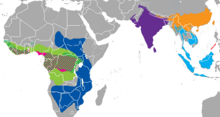| Manidae | |
|---|---|
 | |
| Living species of pangolins | |
| Scientific classification | |
| Domain: | Eukaryota |
| Kingdom: | Animalia |
| Phylum: | Chordata |
| Class: | Mammalia |
| Clade: | Pholidotamorpha |
| Order: | Pholidota |
| Suborder: | Eupholidota |
| Superfamily: | Manoidea |
| Family: | Manidae Gray, 1821 [3] |
| Type genus | |
| Manis | |
| Genera | |
[see classification] | |
 | |
| Synonyms | |
list of synonyms:
| |
Manidae ("spirits") is the only extant family of pangolins. [5] This family comprises three genera ( Manis from subfamily Maninae, Phataginus from subfamily Phatagininae, and Smutsia from subfamily Smutsiinae), [6] [7] as well as the extinct Fayum pangolin. [8]